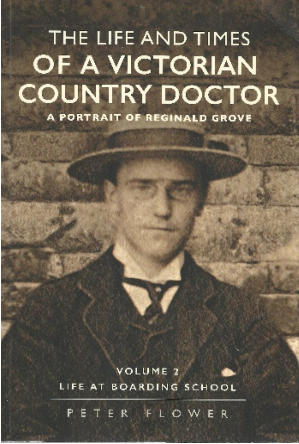The Life and Times of a Victorian Country Doctor -
A Portrait of Reginald Grove - Volume 2 - Life at Boarding Schoo
l
By Peter Flower
Published by Brown Dog Books, 2021. ISBN 978-1-8395-2206-2
Available from the Self-Publishing Partnership.
This
handsomely
produced
360page,
well-illustrated
paperback
is
one
of
the
trilogy
produced
by
Peter
Flower
based
upon
the
diaries
of
his
grandfather
who
was
for
many
years
Medical
Officer
of
Health
at
St
Ives.
Its
interest
to
Rutland
lies
in
the
fact
that
Grove
(like
Flower
himself
in
the
1960s)
was
a
schoolboy
between
the
years
1883
and
1887
at
Uppingham
School.
These
were
the
last
years
of
the
tutelage
of
the
great
Victorian headmaster Edward Thring.
This
second
volume
of
biography
is
chiefly
concerned
with
Grove’s
days
at
Uppingham
School.
Although
quoting
diary
extracts,
the
chief
benefit
of
this
publication
is
the
considerable
research
that
Flower
has
done
both
at
Uppingham
School
and
elsewhere,
to
illustrate
the
life
of
the
Victorian
schoolboy
at
Uppingham
at
the
time.
Flower
manages
to
extract
and
condense
published
contemporary
school
memoirs
as
well
as
current
historiography
relating
to
Thring
and
Uppingham
written
by
Tozer
and
Richardson,
supplementing
it
with
material
from
school
archives.
This
has
resulted
in
a
publication
of
considerable
significance
to
those
interested
in
the
development
of
Victorian public schools and of Uppingham in particular.
Although
considerable
emphasis
is
given
to
the
religious
background
to
the
teaching
(much
is
made
of
Thring
and
his
'mission'),
the
subjects
taught,
ranging
from
classics
through
to
science
and
games,
as
well
as
most
aspects
of
school
life
at
the
time,
are
comprehensively
explored
in
the
various
chapters.
A
chapter
is
devoted
to
an
unfortunate
case
of
bigamy
concerning
one
of
the
schoolmasters,
which
caused
a
minor
scandal
at
the
time.
Life
in
Uppingham
town
itself
is
also
covered
giving
some
details
from
various
sources.
There
are
extensive,
fulsome
and
useful
footnotes
to
the
text.
However,
there
is
some
repetition
between
the
text
and
footnotes.
In
some
cases
queries
raised
by
the
text
are
answered
by
the
footnotes
of
a
later
chapter.
Overall
this
volume
is
to
be
commended
for
breath
of
its
coverage
and
should
be
consulted
as
a
starting
point
by
anybody
interested
in
the
development of Victorian Uppingham.
Dr Hilary Crowden

Researching Rutland
Copyright © Rutland Local History and Record Society. - All rights reserved
Registered Charity No 700273


Book Review



Researching Rutland
© Rutland Local History and Record Society
Registered Charity No 700273

Book Review
William Browne’s Town: The Stamford Hall Book 1465-1492
Stamford Survey Group in association with Stamford Town Council and
Stamford Civic Trust
Stamford is fortunate to have a Hall Book, a record of the council minutes
of the town. Until now it has remained in the town’s archives only to be
seen by historians with an appointment. With this transcript Alan Rogers
has made the first part of the Hall Book accessible to all and we are given
the opportunity to step back in time and discover what life was really like
in the fifteenth century. Future volumes are planned which will continue
the story of Stamford’s town affairs.
The book gives a remarkable insight into the lives of townspeople in
medieval England covering the years from 1465, shortly after the town’s
incorporation, until 1489 just after the death of William Browne. William
Browne was a very rich and important Merchant of the Staple. He
controlled the affairs of the town during this period, serving as Alderman
on several occasions. His legacy to Stamford is All Saints’ Church and
Browne’s Hospital.
As today, rules and regulations governed the lives of townsfolk. The
minutes record laws forbidding Sunday trading and fines for leaving
horses tied up in the wrong places on market days – as the editor
comments, ‘There were parking penalties even in medieval Stamford’. We
also find that there were designated places for dunghills and times when
animals could be brought into town. From this book we learn how law
and order was enforced and the punishments meted out to wrongdoers.
Perhaps the most interesting aspect of the volume is the tremendous
number of different trades pursued in the town. The wardens strictly
controlled the craftsmen to ensure the quality of goods and there was a
diversity of rules governing the guilds and the pageant of Corpus Christi.
Alan Rogers has had close links with Stamford and readers will no doubt
be familiar with his books The Medieval Buildings of Stamford
(Nottingham 1970), The Book of Stamford (Buckingham 1983) and, with
JS Hartley, The Religious Foundations of Medieval Stamford
(Nottingham 1974). He has also been closely involved with local history in
Rutland, most recently in Uppingham, inspiring and encouraging local
historians to record aspects of the history of that town.
For this volume Professor Rogers has written an excellent introduction
including the insight he has gained about the role of William Browne in
making the transcript. He also adds useful comments throughout the
volume and there is an excellent index. It is a shame that the Editorial
Conventions are not at the front of the book and a glossary would have
been useful for those less familiar with the legal terms of the medieval
period. Do not however be deterred by the plain cover: inside it is a
fascinating record not just for people in Stamford but for anyone
interested in town life in the Middle Ages. It is a book to dip into, and read
aloud it comes to life. It certainly merits a place on the bookshelf of
anyone interested in history.
Jean Orpin







